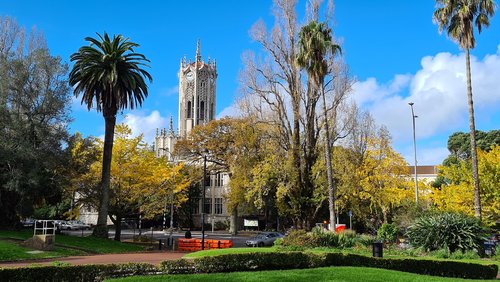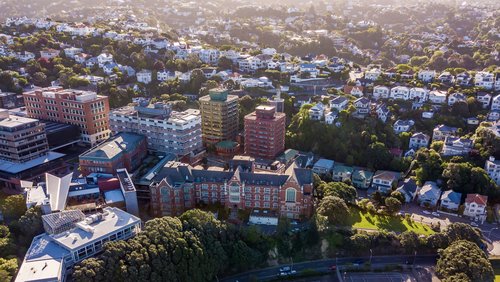15 Oct 2020
Engineers are in a unique position to help solve the complex problems the world now faces, says eminent engineer Delwyn Moller.
Recognised University of Auckland Adjunct Professor Delwyn Moller has spent her career developing state-of-the-art remote sensing systems for measuring critical aspects of the Earth’s surface to support science research and applied sciences.
Delwyn says while she has a creative inclination and considered a career in architecture, engineering was a practical choice because of the solid vocational options it gave her.
“But retrospectively, I realised that engineering is about problem solving and if you are creative in your problem solving, that’s when the fun comes in.”
Joining NASA
After completing a Master’s in electrical engineering at the University of Auckland, Delwyn earned a PhD from the University of Massachusetts Amherst. After her studies she joined one of National Aeronautics and Space Administration’s (NASA’s) prime contractors, Jet Propulsion Laboratory (JPL).
“It was a pretty awesome first experience,” says Delwyn.
“In terms of working on a space mission, I got to work with astronauts, with the shuttle, go to the Johnson Space Centre, and be part of the mission control centre. It was the ultimate geek experience.”
At JPL, Delwyn worked on radar technology, primarily with a focus on Earth science. One project involved the airborne development of vegetation mapping, and another, a channel radar topography mission, which mapped the earth from plus or minus 60 degrees latitude in 10 days.
She says the staff of 5,000 – which is the same as the population of Wanaka, where she now lives – was very international. While she met few fellow Kiwis there, New Zealand-born rocket scientist William Pickering had headed the organisation for 22 years, “although he of course was before my time”.
“I was at JPL for 11 years, before moving to a small company called Remote Sensing Solutions (RSS) where I continued my NASA research.”
At JPL and RSS, Delwyn developed innovative remote sensing systems for measuring critical aspects of the Earth’s surface, including ocean currents, terrestrial hydrology and topography, snow and ice mapping, and soil moisture.
“I spent years working on advanced techniques for imaging radars, and the highlight for me was seeing one of the instruments I had worked on playing a key role in a NASA Earth Venture Mission.
“In this case, it was sub orbital and circumnavigated Greenland four years in a row, mapping marine terminating glaciers to look at the mass change of the ice sheet.”
She says that to have developed something that contributed to the first large-scale look at those dynamics and mechanisms, and making a real contribution to the climate science community, made her very happy.

Delwyn Moller
Returning to her roots
After winning multiple prestigious awards, including being a co-recipient of the NASA Space Act Award for a planetary landing radar design, Delwyn moved back to New Zealand in 2018 for personal and professional reasons.
“I have two children, both New Zealand and US citizens, and we’d visit, but I wanted them to feel they belonged to both countries.
“Professionally, it became an intriguing option which I might not have considered earlier. The formation of the New Zealand Space Agency and of course, Rocket Lab, opened up the potential that perhaps I could actually work in this field in New Zealand.”
Now, she says, she wears a few hats.
“I’m an adjunct professor at Auckland University, where I’m working on two projects. One is Forest Flows through Scion, which will be using remote sensing to look at forest hydrology.”
The other is a world first, whereby Air New Zealand, the University of Auckland and NASA are working together to monitor climate change impacts, with the airline set to collect unique environmental data during domestic flights.
“It involves listening to GPS signals and looking at the difference between what comes directly from satellites and what gets bounced off the earth. This difference tells us something about what’s going on with the surface that the signal interacted with.”
She says because aircraft fly so much lower than satellites, the images received are much higher in resolution and quality. She says with the frequent but long-term high-quality data, "the better we are able to see seasonal and annual changes over multiple years, and therefore determine the effects of human irrigation, susceptibility towards droughts and flooding, and climate changes in general”.
“The reason NASA is so excited about this is that it helps them interpret the complex signatures they are seeing from their satellites and helps them design their next satellite mission. It’s going to be fabulous science. I’m just super excited.”
The real world will provide new challenges, make you a better engineer, and you will actually make something better for society.
The impact of Covid-19
But as with almost everything, Covid-19 is having an impact on Delwyn’s work, although she and her University of Auckland team are able to keep working on the project.
“I fly back to the US four times a year, and was planning on having people come down here for integration and tests. I’m working on hardware, for which at times, you do need to be physically present.”
She says Covid-19 exposes where we need to start focusing to be self-sufficient.
“There are going to be lots of challenges, New Zealand has a closed border, other countries have closed their labs. I’m used to working around problems, but this pandemic, this of course is a new one”.
Engineer is a verb
Delwyn says real-world problem-solving is key to being an effective engineer.
“If you are an engineer, it is not just a title, it is also a verb. You are supposed to do something. Find the problems that get you excited and think creatively about a solution.”
She urges innovative engineers to take their work into the real world.
“Sitting in front of the computer simulating something is just one step of the process. The real world will provide new challenges, make you a better engineer, and you will actually make something better for society. Do something with your time that is actually creating a benefit.”
Delwyn says her driving motivation is that she wants to make a difference in the world.
“When lockdown first happened, I almost found myself getting into that helpless and depressed thinking, there was so much uncertainty, we just didn’t know how it was going to go.
“I’m living in Wanaka, where it’s going to be incredibly hard hit, where people are going to lose their jobs, and I went ok, what can I do with my skillset that can make a difference? Then I read an article by Dame Anne Salmond calling for a green economic recovery, and realised that was where I could make a start.”
She says New Zealand needs to turn back to primary industries for its economic recovery, but in a sustainable fashion.
“I now have a couple of projects that are progressing, although it’s a little early to discuss them. But they are looking toward a green economic recovery, such as supporting optimised resource management and regenerative agriculture. That’s where we can make a real contribution, and remote sensing technology can help us manage our resources.”
Meanwhile, life in Wanaka is not all work for Delwyn, who is also a helicopter pilot and a brown belt in jiu jitsu. She and her partner have established jiu jitsu classes for children in the town, now offering eight classes a week.
“This is such a privilege.”
This article originally appeared in the September 2020 issue of EG magazine.




